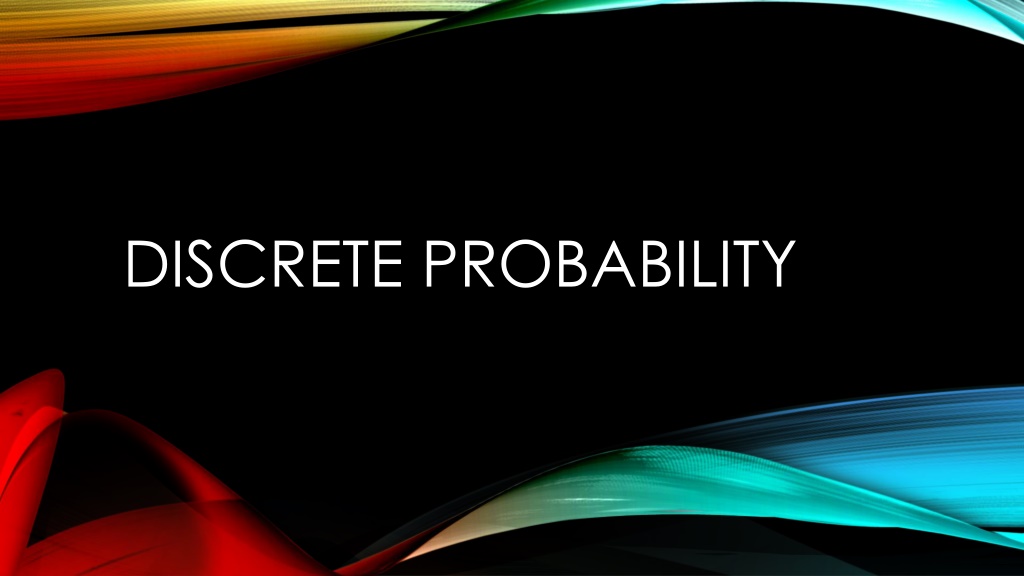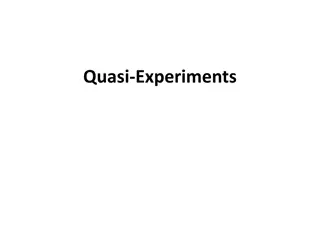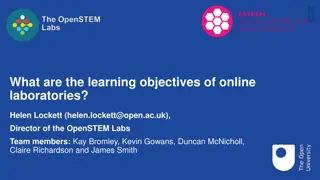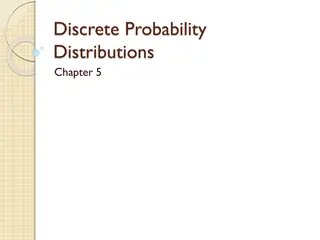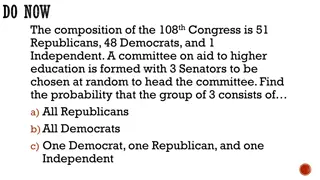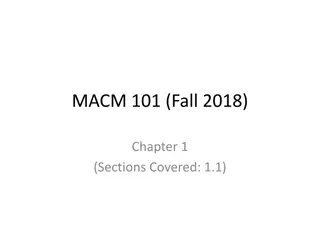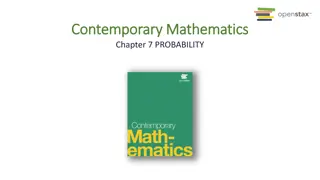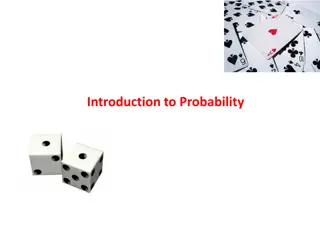Understanding Discrete Probability in Experiments
A trial is a single event with possible outcomes, while a sequence of trials forms an experiment. For example, flipping a coin results in outcomes like heads, tails, or on edge, creating a sample space. This concept delves into the essence of discrete probability and how it applies to various experiments.
Download Presentation

Please find below an Image/Link to download the presentation.
The content on the website is provided AS IS for your information and personal use only. It may not be sold, licensed, or shared on other websites without obtaining consent from the author. Download presentation by click this link. If you encounter any issues during the download, it is possible that the publisher has removed the file from their server.
E N D
Presentation Transcript
A trial is a procedure that yields one of a set of possible outcomes. A sequence of trials is an experiment. Flipping a coin is a trial. The sample space is the set of possible outcomes {heads, tails, on edge} An event is a subset of the sample space {heads, on edge} You roll two dice, and are wondering if you ll get snake eyes (two 1 s). DEFINITIONS What is the trial? Rolling two dice What is the sample space? {1,2,3,4,5,6} x {1,2,3,4,5,6} What is the event? Snake eyes What is the probability of the event? 1/36
In the previous problem, we assumed something. The uniform distribution assigns the probability 1 to each of the n elements in the sample space. An unbiased coin assigns tails An unbiased die assigns Two unbiased dice assigns If S is a sample space of equally likely outcomes, and E is an event of S, then the probability of E is ? 12to both heads and THE UNIFORM DISTRIBUTION 16to each side. 136to each result. |?| |?| ? ? =
PRACTICE What is the probability that the sum of two dice rolls is 7? 6 36= 1 6 How many 5-card Poker hands are there? 52 5 How many 5-card Poker hands contain a 4-of-a-kind? 13 48 What is the probability of a 4-of-a-kind? 13 48 52 5 = 0.024% What is the probability of a full house? 4 3 4 2 13P2 52 5
You have a sequence of 10 bits, generated by the uniform distribution. What is the probability that at least one bit is a 0? 1210 1 INVERTING PROBABILITIES Given event E in sample space S, the probability of the complement of E is: ? ? = 1 ?(?)
THE SUBTRACTION RULE FOR DISCRETE PROBABILITIES There is a line of 100 people. Everyone at an even position is a pirate. Everyone at a position divisible by 5 is a ninja You choose a person in the line according to the uniform distribution. What is the probability they are a pirate or ninja (or both)? 1 2+1 1 10=3 5 5 p(E1 E2) = p(E1) + p(E2) p(E1 E2) This is also known as the inclusion-exclusion principle.
THE MONTY HALL THREE-DOOR PUZZLE There are three doors. Behind one is a car. Behind each of the other two doors is a goat. You choose one door, but don t open it. The gameshow host knows where the car is. The gameshow host intentionally chooses a door which you did not choose, which does not have the car, and opens it, revealing a goat. You can now open the door you originally chose, or the other closed door. What should you do?
MONTY HALL Intuition A: there are two doors left, and each is equally likely, so it doesn t matter which door you open. Intuition B: when you guessed which door to open, you had a having a car. That is still the case, so the other doors has a car. So, you should switch doors. 13chance of it 23probability of a Intuition B is correct. Why?
There are three doors. Behind one is a car. Behind each of the other two doors is a goat. You choose one door (door A), but don t open it. The gameshow host knows where the car is. The gameshow host decides to give you a hint. He tells you that if the car is behind door B or C, then it is not behind door C. To drive the point home, he opens door C to reveal a goat. By switching to door B, you effectively get to open two doors and take the better of the prizes. MONTY HALL REPHRASED
MONTY HALL FOR THE UNCONVINCED There are 100 doors. Behind one is a car. Behind each of the other 99 doors is a goat. You choose one door (door 1), but don t open it. The gameshow host knows where the car is. The gameshow host opens 98 other doors, not including your door, and not including the door with the car. Does the probability you originally chose the correct door magically increase from 1100to 12? (No)
NON-UNIFORM DISTRIBUTIONS A biased coin is twice as likely to come up heads as tails. What is the probability it comes up heads? 23 If S = {x1, , xn} is the sample space, then ? ?(??) = 1 and ?:0 ?(??) 1 ?=1
THE SUM RULE FOR PROBABILITY A biased die has a 3 appear twice as often as any other individual number. What is the probability an odd number is rolled? 17+ 27+ 17= 47 ? ? = ?(?) ? ?
For the same biased die, we know that an odd number was rolled. What is the probability a 3 was rolled? 27 47 12 = CONDITIONAL PROBABILITY The conditional probability of E, given that F occurred, is: ? ? ? =?(? ?) ?(?)
PRACTICE There are 4 people in line. Each person is either a pirate or a ninja (but not both), assigned by the uniform distribution. What is the probability there are two consecutive ninja, given the first person in line is a ninja? NNPP NNPN NNNP NNNN NPNN 58
A family has two children, the gender is generated u.a.r. (uniformly at random) What is the probability of two boys, given the youngest is a boy? 12 A family has two children, the gender is generated u.a.r. (uniformly at random) What is the probability of two boys, given at least one boy? PRACTICE Intuition A: This is just the same problem, right? So it is 12? Intuition B: There are 3 possible events: BG, GB, BB. So it is 13? Intuition B is correct.
FOR THE UNCONVINCED Gather data from all U.S. families with exactly 2 children (lets say there are 10 million). 2.5 million families have two girls. 2.5 million families have two boys. 2.5 million families have BG. 2.5 million families have GB. Given there is at least one boy, there are 7.5 million families we might have selected from. Of them, 13of them have two boys.
For any partition of the sample space into disjoint events ?1, ,?? Where ?1 ??=? and ?1 ?? THE LAW OF TOTAL PROBABILITY = : ?(?) = ?(?|?1) ?(?1) + + ?(?|??) ?(??) Because: ?(? ?1) ?(?1) = ? ? ?1+ + ?(? ??) ? ?1+ +?(? ??) ? ? = ? ?? ?(??)
Two events E and F are independent exactly when ?(?|?) = ?(?) ? ? = ? ? ? =?(? ?) ?(? ?) ?(?) ? ? ? = ? ? ?(?) ?(?) DEFINITIONS = ?(?) So an equivalent definition of independence is when ? ? ? = ? ? ?(?)
PRACTICE A family has 2 children, the gender is determined u.a.r. The event E is when there are two girls. F is when there is at least one girl. Are E and F independent? ? ? ? =1 No. p E = 34 3 14 ? ? = ? ? ? ? = 16 4 The family has 3 children. E is when there is a boy and a girl. F is when there is at most 1 boy. Are E and F independent? ? ? ? =3 Yes. p E = 34 3 12 ? ? = ? ? ? ? = 8 8 There are 4 people in line. Each person is a pirate or ninja (not both), generated u.a.r. E is when the first person is a ninja. F is when there are an even number of ninjas. Are E and F independent? ? ? ? =1 Yes. 12 12 14 ? ? ? ? = p E = ? ? = 4
PRACTICE You have a jar with 6 red marbles and 4 blue marbles. You draw 3 of them from the jar, u.a.r. Let E be the event where not all marbles are the same color. Let F be the event where the first marble drawn is red. Are E and F independent? 35 ? ? = 4 3 = 6 3+ 15 45 ? ? = ? ? = 10 3 35 1 59 1330 12= ? ? ? = Not independent!
INDENDENCE OF MANY EVENTS Events E1, Enare pairwise independent if every pair of events are independent. They are mutually independent if, for any subset of events, they are independent. Events F1, , Fkare independent if ? F1 Fk= ? F1 ... ?(Fk)
Consider 2 fair coin flips. E1is the event where the first flip is heads. E2 is the event where the second flip is heads. E3 is the event where exactly one flip is heads. Are these pairwise independent? Mutually independent? p(E1) = p(E2) = p(E3) = p(E1 E2) = p(E1 E3) = p(E2 E3) = p(E1 E2 E3) = 0 Pairwise, but not mutual. PRACTICE 12 14
An integer between 1 and 8 inclusive is chosen u.a.r. E1 is the event that the number is 4. E2 is the event that the number is odd. E3 is the event that the number is prime. Pairwise independent? Mutually independent? p(E1) = p(E2) = p(E3) = p(E1 E2 E3) = p(E2 E3) = 8 Neither! PRACTICE 12 18 3
What are the odds that two people watching this lecture share the same birthday? Is it above or below 50%? Assume that any of the 366 possible birthdays are equally likely. The probability that among n people, two have the same birthday, is: 1 366 366 365 366 364 366 367 ? 366 n = 10: 11.7% n = 23: 50.7% n = 30: 70.6% n = 50: 97% n = 70: 99.9% n=367: 100% THE BIRTHDAY PARADOX
BERNOULLI TRIALS A Bernoulli Trial is a trial with 2 outcomes that may or may not have equal probability. One outcome is the success with probability p, the other is the failure with probability q = 1-p. If you have an experiment of n identical Bernoulli trials, the probability of getting exactly k successes is: ? ? This looks like the Binomial Theorem! ???? ?
PRACTICE A biased coin has probability of heads what is the probability of exactly 2 heads? 4 2 There are 10 people in line. Each person has a 90% chance of being a pirate, and is otherwise a ninja. What is the probability of exactly 8 pirates? 10 2 23. Given 4 flips, 23 13 2 2= 30% 910 110 2 8= 19%
RANDOMIZED ALGORITHMS Suppose a group of size n got together yesterday, and they re worried that they contracted coronavirus during this gathering. Let s say that enough social mingling occurred that if even one person had it, then each person now has a 10% of having it now. You could test everyone from the gathering, but that s not feasible given the limited number of tests we have. Instead, you can test k of the members (chosen u.a.r.), and assert that if no one tests positive, then no one contracted the virus at the gathering. If no one actually contracted the virus, what is the probability you will assert as much? 100% If someone did contract the virus, what is the probability you will incorrectly assert that no one did? 10)k 9 ( If k = 66, this is < 0.1%. If k = 132, this is < 0.0001%
This was an example of a Monte Carlo randomized algorithm: such an algorithm is always fast, but sometimes returns the wrong answer. When you get to them in CSCI 104, you will see that a Bloom Filter is a Monte Carlo data structure. The other type of randomized algorithm is a Las Vegas algorithm: it is always right, but sometimes takes a long time. QuickSort, and HashTables, are examples of this type. RANDOMIZED ALGORITHMS
THE PROSECUTORS FALLACY You are accused of speeding. The prosecutor notes that you have a radar detector (it detects when police are using their radar system which identifies speeders). The prosecutor also notes that 80% of speeders have radar detectors, so you are probably guilty. Is there any flaw in his reasoning? It could be that 1% of the population speeds, but 80% of all drivers have radar detectors, for example. Now the same argument indicates you probably aren t guilty! The fallacy is mistaking p(E|F) for p(F|E)
Alice and Bob are studying for the CSCI 104 midterm. They each do 25 practice problems, split over 2 types (graphs and probability). Bob does 5 graph problems, and gets 3 of them right. Alice does 20 graph problems, and gets 13 of them right. Bob does 20 probability problems and gets 15 of them right. Alice does 5 probability problems and gets 4 of them right. Bob got a 60% on graphs, Alice got a 65% (Alice did better). Bob got a 75% on probability, Alice got an 80% (Alice did better). Bob got 18 out of 25 problems right, Alice got 17 out of 25 right (Bob did better overall). SIMPSON S PARADOX
SIMPSONS PARADOX A new study promotes the benefits of a specific diet. 3 out of 8 of the residents of Roshar survive to age 70 on diet 1. 40 out of 90 of Roshar residents survive on diet 2. 60 out of 92 of the residents of Tyrea survive to age 70 on diet 1. 7 out of 10 of Tyrea residents survive on diet 2. 63% of people on diet 1 survive, vs. 47% on diet 2. This is not enough information to extol the benefits of diet 1!
SIMPSONS PARADOX 38% of the residents of Roshar survive to age 70 on diet 1. 44% of Roshar residents survive on the new diet (diet 2). 65% of the residents of Tyrea survive to age 70 on diet 1. 70% of Tyrea residents survive on the new diet. It looks like diet 2 is the better diet! The natural longevity of Tyreans made diet 1 look better than it was.
A MOTIVATING PROBLEM There are two boxes. Box 1 contains 2 gold coins and 7 cardinal coins Box 2 contains 4 gold coins and 3 cardinal coins You choose a box u.a.r. From your box, you choose a coin u.a.r. You draw a cardinal coin What is the probability the coin came from the first box?
A MOTIVATING PROBLEM E is the event that you draw a cardinal coin. F is the event that you draw from box 1. Calculating p(E|F) is easy ( We want to calculate p(F|E) (much harder!) 79)
A MOTIVATING PROBLEM ?(? ?) ?(?) ? ? ? = ? ? ? ? ? = ? ? ? = ? ? ? ? ? ? ? ? =?(?|?) ?(?) ?(?) Bayes Theorem: ?(?|?) ?(?) ? ? ? = ? ? ? ? ? + ?(?| ?) ?( ?)
A MOTIVATING PROBLEM 12 ? ? = ? ? = ? ? ? = ? ? ? = 79 79 79 37 12 37 ? ? ? = = 64% 12+ 12
PRACTICE Say that 10% of the population has coronavirus. 85% of those infected display a fever. 5% of those who are not infected display a fever (from other causes) You display a fever. What is the probability you have coronavirus? E = you display a fever. F = you have coronavirus. p E F = 85%,? ? ? = 5%,? ? = 10% 85% 10% ? ? ? = 85% 10% + 5% 90%= 65%
ODDITIES FROM BAYES THEOREM Suppose there is a much rarer disease that infects 1 out of 100,000 people. You have a very accurate test for the disease: If you have the disease, it correctly says so 99% of the time. If you don t, it correctly says so 99.5% of the time. You take the test, and it comes back positive. What is the probability you have the disease? E = test comes back positive, F = you have the disease. ? ? ? = 99%,? ? ? = 0.5%,? ? = 0.001% 99% 0.001% 99% 0.001% + 0.5% 99.999%= 0.2%??? ? ? ? =
XKCD #1132 FREQUENTISTS VS. BAYESIANS
BAYES THEOREM: OTHER VERSIONS A simpler version: ? ? ? =?(?|?) ?(?) ?(?) A more complex version, for any partition of the sample space into distinct sets F1, , Fk: ? ? ? = ? ? ?1 ? ?1+ + ? ? ?? ? ?? ?(?|?) ?(?)
There are 3 doors. You choose door 1. The host then opens door 2 to reveal a goat. What is the probability the car is behind door 3? Fi= the car is behind door i. E = the host opens door 2. ? ? ?3= 1,? ? ?2= 0, because the host never opens the door with the car. MONTY HALL REVISITED 12, because the host can open door 2 or 3. p F?= 1 12 ? ? ?1= 13 13 13+ 1 = 23 ? ?3? = 13+ 0 13
DEFINITIONS A Random Variable is a mapping from the sample space to the set of real numbers. That is, every single outcome is assigned a number. If your trial is to flip 3 coins, there are 8 possible outcomes. You could have a random variable X that calculates the number of heads for each outcome: X(HHT) = 2, for example The distribution of a random variable is the probability of each possible number. So for the above trial: 18= ? 3 38= ?(2) ? 0 = ? 1 =
A DICE PROBLEM You roll two fair dice. X(t) is a random variable that outputs the sum of the dice. What is the distribution of X? 136= ?(12) 236= ? 11 336= ?(10) 436= ? 9 536= ? 8 636 ? 2 = ? 3 = ? 4 = ? 5 = ? 6 = ? 7 =
In 1940, two mathematicians were planning to publish papers about random variables, and they were trying to decide what to call them by (random variable or chance variable, each preferred by one of the mathematicians). Given the subject matter, how do you suppose they decided? They flipped a coin, and we ve been stuck with random variable ever since. RANDOM VARIABLES: ORIGINS
EXPECTATION The Expected Value E(X) of a random variable X is the average value outputted by X. That is: ? ? = ?(?) ?(?) ? ? What is the expected value of a fair die roll? 16 1 + 16 2 + 16 3 + 16 4 + 16 5 + 16 6 = 3.5 Given n Bernoulli trials, each with probability of success p, what is the expected number of successes? np Wait why could we do that?
LINEARITY OF EXPECTATIONS E(X1+ + Xn) = E(X1) + + E(Xn) E(a X + b) = a E(X) + b That is, if you want to calculate the expected number of successes over n trials, you can calculate the expected number of successes for the 1sttrial, and the 2ndtrial, and the 3rdtrial, etc, and add them all up. What is the expected value of the sum of 3 fair dice? 3 3.5 = 10.5 Professor Slacker hates grading, and just assigned each student a grade (A, B, C, or D) u.a.r. If he had actually bothered to grade, he would have given 25% of students each grade. What is the expected percentage of students that got the correct grade? 25%
PRACTICE The ordered pair i,j is an inversion in a permutation of the first n positive integers if i < j, but j precedes i in the permutation. There are 6 inversions in 3, 5, 1, 4, 2 1,3 , 1,5 , 2,3 , 2,4 , 2,5 , 4,5 What is the max number of inversions in a list of n positive integers? ? 2 What is the expected number of inversions in a random permutation of the first n positive integers? ? (? 1) 4 =? (? 1) 2
EXPECTATION ON NON-INDEPENDENT RANDOM VARIABLES You have two coins. One has heads on both sides, the other has tails on both sides. You choose a coin u.a.r., and then you flip it twice. What is the expected number of heads? 1 Linearity of Expectations holds, even if the variables aren t independent!
INSERTION SORT What is the expected number of comparisons made by Insertion Sort? Let Xibe the number of comparisons to insert the i-th element. We want to calculate E(X1 + + Xn) By Linearity of Expectations, we can just calculate E(X1), , E(Xn) E(X1) = 0, because the first item is already in the correct position. X2 will always output 1, because we need to compare a1and a2. E(X2) = 1 X3 will always output at least 1. If we find it to be the largest element so far, it will only output 1. Otherwise we will do another comparison with the smallest element, and it will output 2. There are 2 cases where we do 2 comparisons (smallest and 2ndsmallest) E(X3) = 3 5 2 1 3 1 = 3 2 +
